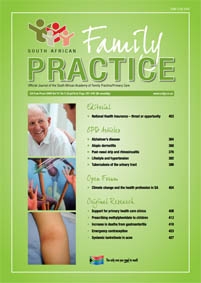Tuberculosis of the urinary tract and male genitalia –a diagnostic challenge for the family practitioner
Keywords:
Tuberculosis, urogenital, urinary tract, male genitalia, extrapulmonary
Abstract
Tuberculosis (TB) of the urinary tract and male genital system can be very difficult to diagnose unless a high index of suspicion is maintained. The most common presenting features of urogenital tuberculosis (UGTB) are lower urinary tract symptoms (LUTS), haematuria, recurrent urinary tract infection (UTI) by Gram-negative organisms, flank pain, and scrotal swelling. The classically described sterile pyuria should arouse suspicion of UGTB, but in about a third of patients a Gram-negative organism is cultured from the urine, so recurrent bacterial UTI should always be further investigated. Intravenous pyelography (IVP) remains the best imaging study available to screen for UGTB, but ultrasound and computerised tomography (CT) imaging can also be useful. The diagnosis of UGTB is most often confirmed with urine culture: at least 3–5 early morning urine specimens must be submitted and the results may take 4–6 weeks. Histological diagnosis on bladder or testicular biopsies can be made if granulomatous inflammation and Ziehl-Neelsen (ZN) positive organisms are seen. HIV-positive individuals are at greater risk of acquiring TB, and patients with confirmed or suspected UGTB should always be tested for HIV infection. Medical treatment of UGTB requires combination anti-TB drug therapy for at least six months. Patients should be followed up closely with monthly imaging because upper tract obstruction may develop due to fibrosis while on therapy. Surgery for UGTB can be extirpative (e.g. nephrectomy) or reconstructive (e.g. enterocystoplasty, to enlarge a fibrotic bladder). The outcome of UGTB is good if the diagnosis is made early, but delayed diagnosis may lead to loss of renal function.- Figure 1: Calcification in TB epididymitis
- Figure 2: Scrotal swelling with draining sinus due to TB epididymitis
- Figure 3: Tuberculosis of the glans penis
- Figure 4: IVP showing papillary necrosis
- Figure 5: Retrograde pyelogram showing multiple cavities in the right kidney caused by TB caseous necrosis
- Figure 6: IVP showing hydronephrosis due to ureteric TB
- Figure 7: Cystogram showing a small, contracted bladder due to TB cystitis
- Figure 8a
- Figure 8b
- Figure 8c
Published
2009-06-09
Section
CPD
By submitting manuscripts to SAFP, authors of original articles are assigning copyright to the South African Academy of Family Physicians. Copyright of review articles are assigned to the Publisher, Medpharm Publications (Pty) Ltd, unless otherwise specified. Authors may use their own work after publication without written permission, provided they acknowledge the original source. Individuals and academic institutions may freely copy and distribute articles published in SAFP for educational and research purposes without obtaining permission.

